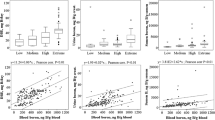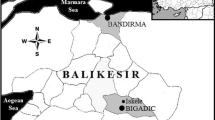Abstract
Boric acid and sodium borates have been considered as being “toxic to reproduction and development”, following results of animal studies with high doses. Experimentally, a NOAEL (no observed adverse effect level) of 17.5 mg B/kg-bw/day has been identified for the (male) reproductive effects of boron in a multigeneration study of rats, and a NOAEL for the developmental effects in rats was identified at 9.6 mg B/kg-bw/day. These values are being taken as the basis of current EU safety assessments. The present study was conducted to investigate the reproductive effects of boron exposure in workers employed in boric acid production plant in Bandırma, Turkey. In order to characterize the external and internal boron exposures, boron was determined in biological samples (blood, urine, semen), in workplace air, in food, and in water sources. Unfavorable effects of boron exposure on the reproductive toxicity indicators (concentration, motility, morphology of the sperm cells and blood levels of follicle-stimulating hormone (FSH), luteinizing hormone (LH), and total testosterone) were not observed. The mean calculated daily boron exposure (DBE) of the highly exposed group was 14.45 ± 6.57 (3.32–35.62) mg/day. These human exposures represent worst-case exposure conditions to boric acid/borates in Turkey. These exposure levels are considerably lower than exposures, which have previously led to reproductive effects in experimental animals. In conclusion, this means that dose levels of boron associated with developmental and reproductive toxic effects in animals are by far not reachable for humans under conditions of normal handling and use.



Similar content being viewed by others
References
Barranco WT, Eckhert CD (2004) Boric acid inhibits human prostate cancer cell proliferation. Cancer Lett 216(1):21–29
Barranco WT, Eckhert CD (2006) Cellular changes in boric acid-treated DU-145 prostate cancer cells. Br J Cancer 94:884–890
Barranco WT, Hudak PF, Eckhert CD (2007) Evaluation of ecological and in vitro effects of boron on prostate cancer risk (United States). Cancer Causes Control 18(1):71–77. Erratum in: Cancer Causes Control. 2007 18(5):583–584
Barranco WT, Kim DH, Stella SL Jr, Eckhert CD (2009) Boric acid inhibits stored Ca2 + release in DU-145 prostate cancer cells. Cell Biol Toxicol 25(4):309–320
Conover WJ (1999) Practical nonparametric statistics, 3rd edn. John Wiley, New York
Culp S, Porter M (2009) The effect of obesity and lower serum prostate-specific antigen levels on prostate-cancer screening results in American men. BJU Int 104(10):1457–1461
Culver BD, Shen PT, Taylor TH, Lee-Feldstein A, Anton-Culver H, Strong PL (1994) The relationship of blood and urine boron to boron exposure in borax workers and the usefulness of urine-boron as an exposure marker. Environ Health Perspect 102(7):133–137
Degen GH, Hengstler JG (2008) Developments in industrial and occupational toxicology: REACH, toxicogenomics, mycotoxins, lead, asbestos, boron, bitumen, deletion polymorphisms and SNP interactions. Meeting report of the 16th EUROTOX Training and Discussion Session. Arch Toxicol 82:483–487
Demange M, Görner P, Elcabache JM, Wrobel R (2002) Field comparison of 37 mm closed-faced cassettes and IOM samplers. Appl Occup Environ Hyg 17(3):200–208
Deviran TA, Volpe SL (2003) The physiological effects of dietary boron. Crit Rev Food Sci Nutr 43:219–231
ECHA [European Chemicals Agency] (2008) Annex XV Transitional reports: boric acid. Available online: http://echa.europa.eu/doc/trd_substances/boric_acid/ann_xv_trd/trd_austria_boric_acid.pdf (accessed 28.07.2010)
Fail PA, Chapin RE, Price CJ, Heindel JJ (1998) General, reproductive, developmental, and endocrine toxicity of boronated compounds. Reprod Toxicol 12(1):1–18
Gallardo-Williams MT, Chapin RE, King PE, Moser GJ, Goldsworthy TL, Morrison JP, Maronpot RR (2004) Boron supplementation inhibits the growth and local expression of IGF-1 in human prostate adenocarcinoma (LNCaP) tumors in nude mice. Toxicol Pathol 32(1):73–78
Holm S (1979) A simple sequentially rejective multiple test procedure. Scand J Stat 6:65–70
IPCS (1998) Envieonmenntal health criteria 204; boron. International Programme on Chemical Safety. World Health Organization (WHO), Geneva
Jensen AA (2009) Risk assessment of boron in glass wool insulation. Environ Sci Pollut Res 16:73–78
Kehinde EO, Mojiminiyi OA, Sheikh M, Al-Awadi KA, Daar AS, Al-Hunayan A, Anim JT, Al-Sumait AA (2005) Age-specific reference levels of serum prostate-specific antigen and prostate volume in healthy Arab men. BJU Int 96(3):308–312
Kort SA, Martens F, Vanpoucke H, van Duijnhoven HL, Blankenstein MA (2006) Comparison of 6 automated assays for total and free prostate-specific antigen with special reference to their reactivity toward the WHO 96/670 reference preparation. Clin Chem 52(8):1568–1574
Kruger TF, Menkveld R, Stander FSH, Lombard CJ, Van der Merwe JP, Van Zyl JA, Smith K (1986) Sperm morphologic features as a prognostic factor in in vitro fertilization. Fertil Steril 46:1118–1123
Kruger TF, Acosta AA, Simmons KF, Swanson RJ, Matta JF, Oehninger S (1988) Predictive value of abnormal sperm morphology in in vitro fertilization. Fertil Steril 49:112–117
Ku WW, Chapin RE, Wine RN, Gladen BC (1993) Testicular toxicity of boric acid (BA): Relationship of dose to lesion development and recovery in F344 rat. Reprod Toxicol 7:305–319
Li SN, Lundgren DA, Rovell-Rix D (2000) Evaluation of six inhalable aerosol samplers. Am Ind Hyg Assoc J 61:506–516
McCoy H, Kenney MA, Montgomery C, Irwin A, Williams L, Orrell R (1994) Relation of boron to the composition and mechanical properties of bone. Environ Health Perspect 102(7):49–53
Müezzinoğlu T, Lekili M, Eser E, Uyanik BS, Büyüksu C (2005) Population standards of prostate specific antigen values in men over 40: community based study in Turkey. Int Urol Nephrol 37(2):299–304
Mungan AG, Erol B, Akduman B, Bozdogan G, Kiran S, Yesilli C, Mungan NA (2007) Values for free/total prostate-specific antigen ratio as a function of age: necessity of reference validation in a Turkish population. Clin Chem Lab Med 45(7):912–916. Erratum in: Clin Chem Lab Med 45(11):1570
Murray FJ (1995) A human health risk assessment of boron (boric acid and borax) in drinking water. Reg Toxicol Pharmacol 22:221–230
Murray FJ, Schlekat CE (2004) Comparison of risk assessments of boron: alternate approaches to chemical-specific adjustment factors. Hum Ecol Risk Assess 10:57–58
Nielsen FH (1994) Biochemical and physiologic consequences of boron deprivation in humans. Environ Health Perspect 102(7):59–63
Nielsen FH (2008) Is boron nutritionally relevant? Nutr Rev 66:183–191
Robbins WA, Xun L, Jia J, Kennedy N, Elashoff DA, Ping L (2010) Chronic boron exposure and human semen parameters. Reprod Toxicol 29:184–190
Sayli BS (1998) An assessment of fertility in boron-exposed Turkish subpopulations, 2. Evidence that boron has no effect on human reproduction. Biol Trace Elem Res 66:409–422
Sayli BS (2001) Assessment of fertility among sibs and in “borate families”. Biol Trace Elem Res 81:255–267
Sayli BS (2003) Low frequency of infertility among workers in a borate processing facility. Biol Trace Elem Res 93:19–29
Sayli BS, Tüccar E, Elhan AH (1998) An assessment of fertility in boron-exposed Turkish subpopulations. Reprod Toxicol 12(3):297–304
Scialli AR, Bonde JP, Brüske-Hohlfeld I, Culver BD, Li Y, Sullivan FM (2010) An overview of male reproductive studies of boron with an emphasis on studies of highly exposed Chinese workers. Reprod Toxicol 29:10–24
R Development Core Team (2010) R: A language and environment for statistical computing. R Foundation for Statistical Computing, Vienna, Austria. http://www.R-project.org
WHO [World Health Organization] (2003) Laboratory manual for the examination and processing of human semen and sperm, 4th edn. WHO Press, Geneva
Xing X, Wu G, Wei F, Liu P, Wei H, Wang C, Xu Y, Xun L, Jia J, Kennedy N, Elashoff D, Robbins W (2008) Biomarkers of environmental and workplace boron exposure. J Occup Environ Hyg 5:141–147
Yazbeck C, Kloppmann W, Cottier R, Sahuquillo J, Debotte G, Huel G (2005) Health impact evaluation of boron in drinking water: a geographical risk assessment in Northern France. Environ Geochem Health 27:419–427
Acknowledgments
This project was funded by National Boron Research Institute (BOREN) and Eti Mine Works General Management (2008–G0207). The outline of the study and the processing of the raw data were reviewed by an external expert panel. The authors thank the reviewers, Professors G. Assennato, Bari, and M. Guillemin, Lausanne, for their scrutiny and dedicated effort.
Author information
Authors and Affiliations
Corresponding author
Electronic supplementary material
Below is the link to the electronic supplementary material.
Rights and permissions
About this article
Cite this article
Duydu, Y., Başaran, N., Üstündağ, A. et al. Reproductive toxicity parameters and biological monitoring in occupationally and environmentally boron-exposed persons in Bandırma, Turkey. Arch Toxicol 85, 589–600 (2011). https://doi.org/10.1007/s00204-011-0692-3
Received:
Accepted:
Published:
Issue Date:
DOI: https://doi.org/10.1007/s00204-011-0692-3




